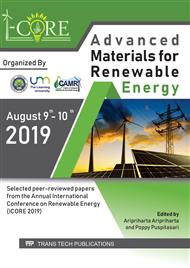[1]
A. Eftekhari, Z. Jian, and X. Ji, Potassium Secondary Batteries,, ACS Appl. Mater. Interfaces, vol. 9, no. 5, p.4404–4419, (2017).
DOI: 10.1021/acsami.6b07989
Google Scholar
[2]
A. Eftekhari, Potassium secondary cell based on Prussian blue cathode,, J. Power Sources, vol. 126, no. 1–2, p.221–228, (2004).
DOI: 10.1016/j.jpowsour.2003.08.007
Google Scholar
[3]
T. Shibata, M. Takachi, and Y. Moritomo, Low Voltage Charge/Discharge Behavior of Manganese Hexacyanoferrate,, Batteries, vol. 3, no. 1, p.7, (2017).
DOI: 10.3390/batteries3010007
Google Scholar
[4]
C. D. Wessells, R. A. Huggins, and Y. Cui, Copper hexacyanoferrate battery electrodes with long cycle life and high power,, Nat. Commun., vol. 2, no. 1, p.550–555, (2011).
DOI: 10.1038/ncomms1563
Google Scholar
[5]
M. S. Chae, J. Hyoung, M. Jang, H. Lee, and S. T. Hong, Potassium nickel hexacyanoferrate as a high-voltage cathode material for nonaqueous magnesium-ion batteries,, J. Power Sources, vol. 363, p.269–276, (2017).
DOI: 10.1016/j.jpowsour.2017.07.094
Google Scholar
[6]
X. Bie, K. Kubota, T. Hosaka, K. Chihara, and S. Komaba, A novel K-ion battery: hexacyanoferrate(ii)/graphite cell,, J. Mater. Chem. A, vol. 5, no. 9, p.4325–4330, (2017).
DOI: 10.1039/c7ta00220c
Google Scholar
[7]
J. Kabesova, M.;Gazo, Structure and classification of thiocyanates and the mutual influence of their ligands,, Chem. Rev., vol. 34, no. 6, p.41, (1980).
Google Scholar
[8]
M. N. Uddin and T. S. Rupa, Thiocyanato Bridged Bimetallic Complexes (M-SCN-Co): Synthesis, Characterization and Biological Studies,, Mod. Chem., vol. 3, no. 1, p.1, (2015).
DOI: 10.11648/j.mc.s.2015030101.11
Google Scholar
[9]
A. E. Özel, Y. Büyükmurat, and S. Akyüz, Infrared-spectra and normal-coordinate analysis of quinoline and quinoline complexes,, J. Mol. Struct., vol. 565–566, p.455–462, May (2001).
DOI: 10.1016/s0022-2860(00)00793-6
Google Scholar
[10]
S. J. Osborne et al., Thermochromism and switchable paramagnetism of cobalt(II) in thiocyanate ionic liquids,, Dalt. Trans., vol. 44, no. 25, p.11286–11289, (2015).
DOI: 10.1039/c5dt01829c
Google Scholar
[11]
G. Lakshminarayana and S. Buddhudu, Spectral analysis of Mn2+, Co2+ and Ni2+: B2O3–ZnO–PbO glasses,, Spectrochim. Acta Part A Mol. Biomol. Spectrosc., vol. 63, no. 2, p.295–304, Feb. (2006).
DOI: 10.1016/j.saa.2005.05.013
Google Scholar
[12]
G. Rogez et al., Tuning the optical properties of Prussian blue-like complexes,, Chem. Commun., no. 14, p.1460–1461, Jul. (2002).
DOI: 10.1039/b202288e
Google Scholar


